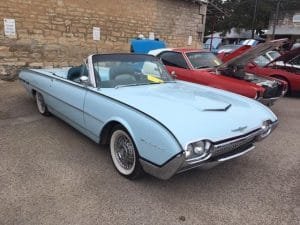When you attend a classic car show you usually see a very impressive array of good looking cars and trucks. Even though the event may be called a classic car show, chances are you’ll see a vehicle that is old enough to make you think, is this vehicle considered classic, antique or a vintage.
 The answer to this question actually depends on who decides. While there is general agreement on the differences, mostly coming from larger auto clubs and associations, each state may have their own criteria which can affect licensing. Different states have different regulations and guidelines as to what actually qualifies as a classic car and/or antique and vintage.
The answer to this question actually depends on who decides. While there is general agreement on the differences, mostly coming from larger auto clubs and associations, each state may have their own criteria which can affect licensing. Different states have different regulations and guidelines as to what actually qualifies as a classic car and/or antique and vintage.
It’s important to note that states set collector car classifications for determing registration fees, safety inspections, and use of the vehicle.
Some Examples
The Indiana Bureau of Motor Vehicles says that a classic car must be at least 25 years old. In that instance, an owner of a car or truck of that age can apply for special “Year of Manufacture” plates.
In Texas, vehicles registered as “Classic” are required to have an annual safety inspection. These types of vehicles are inspected like any passenger vehicle. Certain items of inspection, however, may or may not be required to be inspected, depending on the age of the car. (For example, seat belts and anchorages are only required if the vehicle was originally manufactured with them.) Vehicles registered as “Antiques” are exempt from annual inspection. According to Texas state law a vehicle will be considered an antique if the body, frame and engine are at least 25 years old. Texas also has other requirements about the owner’s age and how you can use your vehicle. There are also requirements for three different types of antique plates.

The Antique Automobile Club of America which was founded in 1935 states that classic automobiles are vehicles that are older than 25 years.
As per the Classic Car Club of America a classic is a “fine” or “distinctive” automobile built between 1915 and 1948. With that being said, there are many states that would consider cars that old to be antique or vintage automobiles.for registration purposes.
When it comes to insurance companies, the classification of a collector car can vary company to company. Many insurance companies designate that a classic car is at least 20 years old but not more than 40 years old. There are also stipulations about what more modern equipment you can add to a classic car and still meet the insurance company’s definition of a classic car.
Car clubs, state governments and insurance companies all have definitions of what is classic, vintage and antique. Each of these entities also have separate reasons why they classify collector cars as they do.
Antique or Vintage..It Can be Both
 Generally, it appears that vehicles over 100 years old are classified as antiques. Vintage is said to be of an earlier generation. What this says is you could have a vehicle that is both vintage and antique. There are also people who might call a car of any age a classic. It can be very confusing and especially when you consider that states differ in how a vehicle is registered. And some car organizations only consider vehicles that are over 45 years old to be antique. Yet, in many states you can register a car as an antique or a “historic” car, after 20-25 years.
Generally, it appears that vehicles over 100 years old are classified as antiques. Vintage is said to be of an earlier generation. What this says is you could have a vehicle that is both vintage and antique. There are also people who might call a car of any age a classic. It can be very confusing and especially when you consider that states differ in how a vehicle is registered. And some car organizations only consider vehicles that are over 45 years old to be antique. Yet, in many states you can register a car as an antique or a “historic” car, after 20-25 years.
Because some people define anything that is antique as very old and dusty, the same rule is often applied when classifying automobiles, which is not a good formula to use. It would be our general agreement that a vintage vehicle may be a car or truck that is over 40 years old but not older than 100 years old. This of course applies to simple classification and, as we’ve mentioned, does not apply to how individual states classify collector cars.